 S3 ViRGE Series (1996-1997)
S3 ViRGE Series (1996-1997)
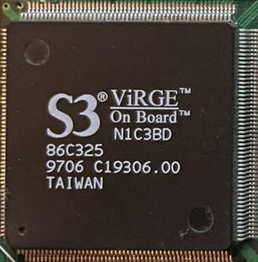
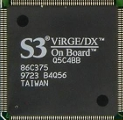
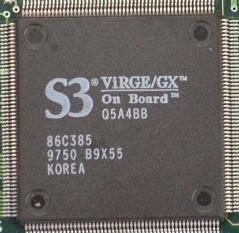
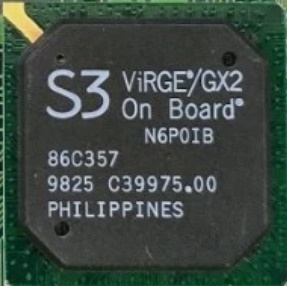
From left: ViRGE (1996), ViRGE/DX (1996), ViRGE/GX (1996), ViRGE/GX2 (1997)
Summary
| Launched | June 1996 | VESA Support | VBE 1.2 built into BIOS, DPMS and DDC. |
| Bus Type | PCI v2.1 (ViRGE, ViRGE/DX, ViRGE/GX, and ViRGE/MX) and AGP 1x (ViRGE/GX2 only) | API Support | S3D, Direct3D, OpenGL [unofficial], RealityLab, Argonaut BRender, Criterion Renderware |
| Chipset | ViRGE | Found on Cards | Diamond Stealth 3D 2000XL (ViRGE) ELSA Victory 3D (ViRGE) Genoa Phantom 3D (ViRGE) Hercules Terminator 3D (ViRGE) Leadtek WinFast 3D S600 (ViRGE) miroMedia 3D (ViRGE) Number Nine 9FX Reality 332 (ViRGE) Orchid Fahrenheit Video 3D (ViRGE) Diamond Stealth 3D 2000XL Pro (ViRGE/DX) Genoa Phantom 3D/DX (ViRGE/DX) Hercules Terminator 3D/DX (ViRGE/DX) ExpertColor 3D/DX (ViRGE/DX) STB Nitro 3D (ViRGE/GX) Diamond Stealth 3D 3000XL (ViRGE/VX) ELSA Winner 3000-M (ViRGE/VX) Number Nine 9FX Reality 772 (ViRGE/VX) VideoLogic GrafixStar 750 (ViRGE/VX) Diamond Stealth 3D 4000 (ViRGE/GX2) |
| Core Clock | 55 MHz (ViRGE, ViRGE/DX and ViRGE/VX) 75 MHz (ViRGE/GX) 83 MHz (ViRGE/MX) 75-100 MHz (ViRGE/GX2) |
||
| Memory | 2 MB or 4 MB of EDO DRAM (ViRGE and ViRGE/DX) 2 MB or 4 MB of SDRAM or SGRAM (ViRGE/GX) 2 MB of 4 of MB VRAM (ViRGE/VX) |
||
| Memory Speed | 55 MHz (ViRGE, ViRGE/DX and ViRGE/VX) 75 MHz (ViRGE/GX) 83 MHz (ViRGE/MX) 75-100 MHz (ViRGE/GX2) |
||
| RAMDAC | 24-bit TrueColor (integrated) | Competitors | S3 Trio3D (1997) Rendition Verite V1000 Matrox Millennium (Oct 1995) Matrox Mystique (May 1996) Number Nine Imagine 128 Tseng Labs ET6000 ATI Rage II (Sep 1996) |
| RAMDAC Speed | 135 MHz (ViRGE and ViRGE/MX) 170 MHz (ViRGE DX, GX and GX2) 220 MHz (ViRGE/VX) |
Introduction
 Following the early success of their Trio integrated graphics accelerator chipset, S3 began work on its successor, the ViRGE, or Video and Rendering Graphics Engine. S3 were quick to realise that demand for hardware 3D acceleration was on the horizon, and ViRGE would be their response to this new market. Where the Trio handled 2D acceleration in hardware acceptably, they would need a whole new sub-architecture to handle 3D, and alongside it they also created their own API that developers could use to quickly write 3D games that would benefit from their new chip. They called this API "S3d", and sadly as we know today, it was not widely-adopted by games developers.
Following the early success of their Trio integrated graphics accelerator chipset, S3 began work on its successor, the ViRGE, or Video and Rendering Graphics Engine. S3 were quick to realise that demand for hardware 3D acceleration was on the horizon, and ViRGE would be their response to this new market. Where the Trio handled 2D acceleration in hardware acceptably, they would need a whole new sub-architecture to handle 3D, and alongside it they also created their own API that developers could use to quickly write 3D games that would benefit from their new chip. They called this API "S3d", and sadly as we know today, it was not widely-adopted by games developers.
The first ViRGE (part #86C325) arrived in 1996. It was a combined 2D and 3D graphics accelerator with a 64-bit memory interface that supported 'single-cycle' EDO (it could start outputting data after only a single clock cycle rather than waiting for the entire row of data to be accessed).
A Diamond Stealth 3D 2000XL with its ViRGE graphics accelerator (1996)
It also supported the video features of the Trio64V+ - the S3 Streams processor for accelerated video and the S3 Scenic Highway direct interface so cards could connect direct to MPEG video feeds. The fact ViRGE was pin-compatible with the Trio64V+ indicates that it was essentially a Trio with their S3d graphics engine added. This graphics engine was actually quite full-featured, with flat and Gouraud shading, texture mapping that included perspective correction, bilinear and trilinear texture filtering, MIP-mapping, depth cueing and fogging, alpha blending, and Z-buffering. The only thing really lacking in this list of specs was triangle setup (so if a game processed 3D rendering using triangles, this would have to be done by the CPU). The original ViRGE could drive a display up to 1280 x 1024 resolution in 256 colours non-interlaced at an impressively high refresh rate of 75 Hz. Dropping the resolution down to 1024 x 768 allowed an increase in colour depth to 64,000 colours, or at 800 x 600 in 16.7 million colours.
There's no doubt about it. The top item on most real gamers' Christmas lists in 1996 is going to be a 3-D board. Once you've seen one of these in action, there's just no going back to processor-driven pseudo 3-D; the difference in graphics speed and detail is simply remarkable. Chip and board manufacturers realize they have something hot on their hands, and they're scrambling to get cool products out in an effort to get their share of your dollars.
The latest contestant in the upcoming Battle of the 3-D Chips is the ViRGE chip from S3. Using what the company calls its S3d architecture, the ViRGE (Video and Rendering Game Engine) chip sports a very competitive feature set: accelerated 3-D rendering, bi-linear filtering, MIP mapping (including tri-linear), transparency, and atmospheric fog, Z-buffering lets the chip - instead of your PC's processor - handle the removal of surfaces that should be hidden from sight, and perspective correction keeps objects and textures from warping.
But perhaps the biggest ace in S3's hand is the ViRGE's pin-compatibility with the company's popular Trio64V+ 2-D accelerator chip. Companies don't need to redesign their existing Trio64V+ based graphics boards to use the chip - just update the board's BIOS ROM and include the ViRGE instead. The ViRGE can also be used on motherboard-based graphics subsystems.
Look for the ViRGE to hit the market around late February on boards in the $200 to $350 range; a high-end ViRGE/VX will follow, offering even greater 3-D acceleration."
Computer Gaming World, February 1996
.jpg) The VRAM-based ViRGE/VX arrived in late 1996. It was more expensive than the ViRGE, and got a lower core and memory clock. Performance-wise, it was slightly faster when run at higher resolutions and colour depths due having a faster-clocked RAMDAC (220 MHz), but was slower than the original ViRGE at lower resolutions of 320 x 200 or 640 x 480. Maximum resolution was increased to 1600 x 1200 [in 16 colours] thanks to its support for up to 8 MB of memory.
The VRAM-based ViRGE/VX arrived in late 1996. It was more expensive than the ViRGE, and got a lower core and memory clock. Performance-wise, it was slightly faster when run at higher resolutions and colour depths due having a faster-clocked RAMDAC (220 MHz), but was slower than the original ViRGE at lower resolutions of 320 x 200 or 640 x 480. Maximum resolution was increased to 1600 x 1200 [in 16 colours] thanks to its support for up to 8 MB of memory.
The third and fourth variants were the ViRGE/DX and ViRGE/GX, landing in November 1996. These didn't add any further 3D capabilities (the original ViRGE was pretty well featured for its time). Instead, they focussed on better performance with improved 3D perspective correction, a full-speed trilinear filter and a higher-clocked RAMDAC. The ViRGE/DX used the EDO DRAM memory of the original ViRGE while the ViRGE/GX added support for SDRAM or SGRAM video memory. The common perception back in 1996/1997 was that the use of SDRAM or SGRAM would automatically result in higher performance over EDO DRAM, and generally that was true, but the ViRGE chips all lacked a texture cache, making the use of this memory very inefficient.
The ViRGE/GX2 was one of the first chipsets to support the new AGP interface, though did little to leverage its capabilities.
The ViRGE/MX arrived at the same time as the ViRGE/GX2 in 1997. Designed for the mobile market, this came with dynamic power management capabilities. A variant of the MX, the MXi came with 2 MB of DRAM integrated on the die for faster memory bandwidth between the graphics processor and its memory for higher efficiency. They also later produced a variant called MX+ which had the capability to drive more than one display.
A summary of the ViRGE range is listed below:
- ViRGE (86C325) - the first version of the chip, developed in 1995 and first seen on cards in 1996. Only available on the PCI bus.
- ViRGE/DX (86C375) - improved 3D engine over the ViRGE and faster 170 MHz RAMDAC. Maximum resolution now 1600x1200. Also adds x and y interpolation for smooth video/TV output. Typical performance gain of 20-40% over standard ViRGE.
- ViRGE/GX (86C385) - same core as DX but supported SDRAM or SGRAM in addition to EDO. Maximum resolution now 1600x1200.
- ViRGE/VX (86C988) - a VRAM-based version, slower than the ViRGE at lower resolutions, but at higher resolutions was faster due to the higher-clocked RAMDAC and dual-ported VRAM providing two 64-bit memory paths. Memory capacity was increased to 8 MB. Maximum resolution now 1600x1200.
- ViRGE/MX (86C260) and MX+ (82C280) - arriving in late 1997 and designed for mobile use with built-in advanced power management. Same performance as GX when same memory is used. MX+ able to output on two displays. Also slightly later versions called MX+ (86C280), MXi (86C262, 86C264), and MXi+ (86C282 and 86C284).
- ViRGE/GX2 (86C356) - the first chip able to run on the AGP bus and fastest of the ViRGE series. Able to output on two displays.
- ViRGE/GX2+ (86C357 and 86C359) - unknown what the differences are compared to the 356.
Here's a comparison table of the ViRGE series in chronological order, as well as the Trio3D:
| ViRGE | ViRGE/DX | ViRGE/GX | ViRGE/VX | ViRGE/MX | ViRGE/GX2 | Trio3D | |
|---|---|---|---|---|---|---|---|
| Release Date | June 1996 | Late 1996 | Late 1996 | Late 1996 | Late 1997 | Late 1997 | Nov 1997 |
| Chip | 86C325 | 86C375 | 86C385 | 86C988 | 82C260/82C280 | 86C356/86C357 | 86C365 |
| Bus | PCI | PCI | PCI | PCI | PCI | PCI, AGP 1x | PCI, AGP 1x |
| Core Clock | 50-80 MHz | 45-83 MHz | 75-83 MHz | 55 MHz | 83 MHz | 75-90 MHz | 100 MHz |
| RAMDAC Clock | 135 MHz | 170 MHz | 170 MHz | 220 MHz | 135 MHz | 170 MHz | 230 MHz |
| Memory Types | EDO | EDO | EDO, SDRAM or SGRAM | VRAM | EDO | SDRAM or SGRAM | EDO or SGRAM |
| Memory Bus Width | 64-bit | 64-bit | 64-bit | 2 x 64-bit | 64-bit | 64-bit | 64-bit |
| Memory Sizes | 2 or 4 MB | 2 or 4 MB | 2 or 4 MB | 2, 4 or 8 MB | 2 or 4 MB | 2 or 4 MB | 2 or 4 MB |
| Memory Clock | 50-80 MHz | 45-83 MHz | 75-83 MHz | 55 MHz | 83 MHz | 75-100 MHz | 90 - 100 MHz |
| Memory Bandwidth | 400 MB/s | 400 MB/s | 600 MB/s | 440 MB/s | 600 MB/s | 720 MB/s | 800 MB/s |
Having built a solid reputation for their 2D acceleration capabilities, the company's move into 3D was unsurprisingly difficult - all the graphics chipset companies were coming up with their own designs against a backdrop of few standards - with differing levels of success. What we now know to be the 3D pipeline, the process of plotting, drawing, filling, texturing, adding lighting, etc., was really up to each manufacturer. Knowing Microsoft's Direct3D was coming drove S3 to time ViRGE's launch to the introduction of that standard, in addition to its own S3D.
The ViRGE, like the Trios that came before it, were all excellent performers at 2D Windows acceleration and had a high degree of compatibility and performance in DOS.
Supported Graphics Modes
The original ViRGE supported resolutions up to 1280 x 1024. The table below outlines the vertical refresh rates possible at each resolution:
| Resolution | 640x 480 | 800x 600 | 1024x 768 | 1280x 1024 |
| 16 colours | 120 | 120 | 85 | 85 |
| 256 colours | 120 | 120 | 85 | 75 |
| 65K colours | 120 | 120 | 85 | - |
| 16.7M colours | 120 | 85 | 75 | - |
The ViRGE/DX and GX increased the max. resolution to 1600 x 1200. The table below outlines the vertical refresh rates possible at each resolution:
| Resolution | 640 x 480 | 800 x 600 | 1024 x 768 | 1152 x 864 | 1280x 1024 | 1600 x 1200* |
| 16 colours | 120 | 120 | 100 | 85 | 85 | 65 |
| 256 colours | 120 | 120 | 100 | 85 | 85 | 65 |
| 65K colours | 120 | 120 | 100 | 85 | 75* | - |
| 16.7M colours | 120 | 120 | 100* | - | - | - |
* Requires 4 MB of video memory
The ViRGE/VX, with its dual-ported VRAM allowed for higher refresh rates at higher resolutions. The table below outlines the vertical refresh rates possible at each resolution:
| Resolution | 640x 480 | 800x 600 | 1024x 768 | 1152 x 864 | 1280x 1024 | 1600 x 1200* |
| 16 colours | 160 | 160 | 120 | 100 | 100 | 85 |
| 256 colours | 160 | 160 | 120 | 100 | 100 | 85 |
| 65K colours | 160 | 160 | 120 | 100 | 100 | 80 |
| 16.7M colours | 160 | 160 | 120 | - | 75 | - |
* Requires 8 MB of VRAM
The ViRGE/GX2 supported these screen resolutions. The table below outlines the vertical refresh rates possible at each resolution:
| Resolution | 640x 480 | 800x 600 | 1024x 768 | 1152 x 864 | 1280x 1024 | 1600 x 1200 |
| 16 colours | 120 | 120 | 120 | 100 | 85 | 85 |
| 256 colours | 120 | 120 | 120 | 85 | 75 | 85 |
| 65K colours | 120 | 120 | 120 | 85 | 75* | - |
| 16.7M colours | 120 | 120 | 100* | 75 | 75 | - |
* Requires 4 MB of video memory, and only then possible in interlaced mode.
VESA VBE (Video BIOS Extensions) 1.2 was built into the BIOS, but S3 had their own VESA driver called S3VBE that took this to 2.0. These days you can use UNIVBE or similar to install the latest VBE version.
Memory
The original ViRGE and ViRGE/DX supported either 2 or 4 MB of Extended Data Out (EDO) DRAM and could operate in single cycle mode. With traditional FPM DRAM, an entire row of memory would need to be processed as a block before data would be passed back to the CPU, taking multiple clock cycles to do that. With single-cycle operation, data would be output from memory on every clock cycle. It had a 64-bit memory path, though the rated speed of its memory only ran at 55 MHz, the same as the Trio64 and Trio64V+ when using 60ns DRAMs. Actually, S3 rated the original ViRGE to run with a memory clock of 50 MHz, though graphics card manufacturers often overclocked this (Diamond's Stealth 3D 2000XL ran at 71 MHz, the ELSA Victory 3D ran at 72 MHz, and Hercules Terminator 3D pushed it all the way with a clock of 78 MHz).
The ViRGE/GX could use either EDO RAM, Synchronous Dynamic RAM (SDRAM) or Synchronous Graphics RAM (SGRAM). Use of SDRAM or SGRAM was really only of benefit when using higher screen resolutions or larger volumes of textures where a high memory throughput was needed. If only using the card for 640 x 480 gaming with low textures, the EDO DRAM card is slightly faster.
The ViRGE/VX used dual-ported VRAM (Video RAM), effectively doubling the memory path to two 64-bit paths and having the RAMDAC able to access the memory without going through the accelerator chip. Memory capacity was also increased on the VX to 8 MB, though 4 MB variants were also sold. Some VX cards like the Diamond Stealth 3D 3000 came with 2 MB on the card and 2 MB on a memory module. Sadly, even with these features, the VX offered no material gains in real-world testing over even the original ViRGE - most likely due to the slower core and memory clocks required to play well with the VRAM.
On all ViRGE chipsets, overclocking the memory also overclocks the core, as the two are synchronised to run at the same speed. With a good-quality ViRGE and memory chips, these can be increased by 50-66%, though the ViRGE/VX stands out as the one ViRGE that won't overclock by anywhere near as much.
The Video BIOS
The BIOS chip on most ViRGE cards is a standard EPROM or EEPROM, such as the common 27C256 or 28C256.
A number of BIOS versions exist for the ViRGE series, and while S3 wrote their own 32 KB reference BIOS, most graphics card manufacturers customised these. I have listed the ones I know in the table below, and have a few BIOS ROM dumps in the Downloads section further down.
| Chipset | BIOS Version | Card (or S3 BIOS if reference ver) |
|---|---|---|
| ViRGE | 1.00-05 | S3 Reference BIOS |
| ViRGE | 1.00.10 | S3 Reference BIOS |
| ViRGE | 1.04 | Diamond Stealth 3D 2000/2000XL |
| ViRGE | 2.03 | Diamond Stealth 3D 2000/2000XL |
| ViRGE | E4d | Hercules Terminator 3D |
| ViRGE | E6e | Hercules Terminator 3D |
| ViRGE | G5h | Hercules Terminator 3D |
| ViRGE | 2.18.08 (9/5/96, 7/22/96 or 04/09/98) | Number Nine 9FX Reality 332 |
| ViRGE/DX and GX | 1.01.03 | S3 Reference BIOS |
| ViRGE/DX and GX | 2.01.07 | S3 Reference BIOS |
| ViRGE/DX and GX | 2.01.16 | S3 Reference BIOS |
| ViRGE/DX | 1.01 | Diamond Stealth 3D 2000 Pro |
| ViRGE/DX | 3.0 | Genoa Phantom 3D/DX |
| ViRGE/VX | 1.02 | Diamond Stealth 3D 3000/3000XL |
| ViRGE/VX | 2.02 | Diamond Stealth 3D 3000/3000XL |
| ViRGE/GX | v2.01.08.01-C1.07.03 | Compaq OEM ViRGE/GX card |
| ViRGE/GX | 1.3 | STB Nitro 3D |
The S3 Brightness Issue (a.k.a. S3 Black Pedestal issue)
Many ViRGE and Trio3D cards suffer from an issue where blacks appear grey - this is caused by timing settings in the video registers being set incorrectly by default. A fix was posted on the Vogons forum here, that involves running several commands in DEBUG that patch it:
C:\DOS\DEBUG.EXE
o 3c4 08
o 3c5 06
o 3c4 27
i 3c5
<at this step subtract 08h from given value>
o 3c5 <resulting_value>
q .
Vogons user Jepael put this code into a couple of simple DOS utilities, which can be downloaded here.
Upgrades and Successors
Toward the end of the ViRGE line, S3 continued their earlier Trio series of graphics accelerators with the 4 MB Trio3D (86C365) arriving in November 1997 and Trio3D/2X (86C368) about a year later which supported up to 8 MB and came in both PCI and AGP 2x bus form.
In 1999 S3 was already almost 2 years into the design of its new series, called Savage3D.
Reception
The ViRGE was marketed well in advance of its actual release, and was therefore widely anticipated. In 1995, Direct3D was in its infancy, and didn't even have that moniker at the time, being just a minor part of DirectX. It wouldn't be until DirectX 2.0 arrived in June 1996 that Direct3D was its own official entity, and the hugely popular DirectX 5.0 was still at least 1 year away after that (August 1997). This meant standardisation hadn't really kicked in, and each graphics chipset manufacturer was working on their own API to entice games developers to work with theirs.
Early reviews of cards running S3 ViRGE (86C325) were published in late 1996. Generally, the S3 was met with good favour, citing its decent 2D image quality, broad 3D feature set and Direct3D compatbility. Sadly, none of the ViRGE chips came with a texture cache, and while performance when rendering non-textured polygons was fairly good, applying textures and Z-buffering added greatly to the burden on the chip, resulting in very poor performance when using these 3D features.
After much anticipation, game-oriented 3D graphics accelerators are finally beginning to hit the streets. I had the opportunity to take a close look at two cards, both based on the S3 ViRGE 3D accelerator, both with 2 MB of video memory (the same brand and speed of memory chips, no less) and both shipping with some titles that take advantage of the onboard 3D acceleration.
The ViRGE: Bolting on 3D
As we noted in last month's 3D technology overview, the S3 ViRGE is based on the Trio64V+ chip, which is used in a number of multimedia accelerators, including those from Diamond and Hercules. The Trio64V+ is a fairly speedy chip in Windows and even has respectable, although not stellar, DOS performance. Although the ViRGE has all the features that game designers would want to use, there is a worry that the 3D acceleration may bog down when many of the features are turned on. The ViRGE feature set includes perspective-corrected texture maps, MIP mapping of textures, bilinear filtering, z-buffering, alpha blending and fog effects. Unfortunately, the few 3D games around don't make extensive use of all features, so only time and tales will tell.
The first wave of ViRGE-basec cards will have 2 MB of EDO DRAM onboard, and will not be expandable. Although the ViRGE's specs call for potential expansion up to 4 MB, the initial product offering only supports 2 MB. This lack of expandability may have some ramifications for gameplay and performance. Most DOS games (and even Windows games) these days will typically run at 640x480. But if the game needs to have a lot of textures loaded into the video memory, there's not enough memory left over the double-buffering , a technique for fast, 3D frame-rate performance. It's likely we'll see resolution scaled down a bit (512x384 is the "sweet spot" here), but color depth can be increased to 16-bit (65,530 colors), which is far better than the old DOS VGA standard.
The 3D Jury Is Out
Although Hercules hadn't released their PowerDrive Windows drivers when we tested the card, they did ship us their version of the S3 ViRGE driver set. On a P166, the Terminator racked up fairly fast Winbench 96 scores. DOS performance was a cut above past S3 chips, and about on par with the Matrox Millennium in VGA.
The Diamond Stealth 3D scored very high on Winbench 96- about the highest score we've seen for an EDO DRAM card. The DOS Cbench scores are identical to the Hercules, as you might expect for an unaccelerated DOS benchmark running on the same chip with the same DRAM (Cbench is a shareware DOS-based 3D benchmark that renders shaded 3D objects, and reports the frame rate).
Both these cards would be a very solid addition to any game player's system. The nod goes to the Diamond card, due to its more straightforward installation and faster Windows performance. However, Hercules has an excellent reputation for support and upgrading their drivers, and their Touch95 utility for managing video modes has some nice features, such as being able to measure the monitor's refresh rate.
However, we can't really comment on 3D performance until more 3D titles ship and a good 3D benchmark arrives.
Many game developers will be supporting the ViRGE, and more will be supporting Direct3D. Until then, either of these cards will perform quite well for the current crop of DOS games and run Windows applications pretty quickly to boot. But like Godot, the 3D-accelerated games are still yet to come - and we'll be waiting.
Bench Test
Diamond Stealth 3D 2000: Winbench 96 in 1024x768x256 colors: 31.4, 640x480x65,000 colors: 21.5. Cbench SVGA: 35.6 fps
Hercules Terminator 64/3D: Winbench 96 in 1024x768x256 colors: 25.3, 640x480x65,000 colors: 30. Cbench SVGA: 35.6 fps"
Computer Gaming World, August 1996
The S3 ViRGE competed directly with the ATI Rage II, Number Nine Imagine 128, Tseng Labs ET6000, Rendition Verite V1000, and Matrox MGA-2064W (Millennium) and MGA-1064SG (Mystique) chipsets. The fastest out of this bunch in 3D was the Rendition Verite and the slowest was the ET6000. It was similar in performance to the first ATI 3D Rage, though the ViRGE had a higher level of compatibility with games due to its Direct3D-compatible Z-buffer support - something lacking in the 3D Rage. The Matrox Millennium was faster, but lacked the 3D feature set of the ViRGE.
By the time the ViRGE/DX, GX and VX arrived in late 1996, 3D Labs had their very quick Permedia 3D accelerator out, and this led the pack in terms of performance and image quality (followed closely by those based on the Rendition Verite V1000), though cards based on this were more expensive. These 2nd-gen ViRGE chips still relied on software drivers to handle 3D features such as transparency, MIP mapping and specular highlighting.
Just as with their 2D accelerators, S3 had a large number of partnerships with OEM system builders including Dell, Compaq, and HP, and ViRGE cards were sold heavily into this market as budget 3D accelerators.
The 3D market was moving incredibly quickly - every six months performance was doubling. By the time the end of 1996 came, 3dfx had launched the Voodoo Graphics - a game-changer when it came to both performance and compatibility. Another big shift that had occurred from mid-1996 to mid-1997 was going from almost none to 100% support for Direct3D by all the main accelerator chip manufacturers and graphics card vendors.
If you're looking for an original ViRGE (86C325) card today, the fastest ones are the ELSA Victory 3D and Hercules Terminator 3D, followed by the Leadtek WinFast 3D S600. Known sluggish cards include the Genoa Phantom 3D and Spider Tarantula 3D. It's worth mentioning that looking for other more generic cards with 35ns-rated EDO DRAM chips doesn't necessarily mean that card is factory-set to run at a faster core/memory clock - you would have to run a utility like MCLK (see Downloads section) to verify the actual clock speed the card is running at.
Images
S3 ViRGE 2 MB card (Diamond Stealth 3D 2000XL Rev.A):
The Diamond Stealth 3D 2000XL came either with 2 MB or 4 MB installed, retailing for $150 for the 2 MB and $180 for the 4 MB version. This early card has 2 MB of 50ns EDO DRAM soldered-in with no option of expansion. It does, however, get TV-out, meaning this was a retail version (not OEM).
S3 ViRGE 4 MB card (Diamond Stealth 3D 2000 Rev.A):
This is DOS Day's contributor Dusko Marincic's card. It's a Diamond Stealth 3D 2000 that came with 2 MB of 50ns EDO DRAM soldered-in plus 2 MB more in the SOJ memory expansion sockets. It does not have the TV-out port.
S3 ViRGE 2 MB card (Number Nine 9FX Reality 332):
The Number Nine Reality 332 I believe came only in 2 MB form. It does however, use 40ns EDO DRAMs, which for an original ViRGE card is nice and fast. Aside from that it's a very basic card with no memory expansion option - it retailed for $159 back in 1996.
S3 ViRGE 2 MB card (ELSA Victory 3D):
Images courtesy of AmoRetro.de
The ELSA Victory 3D came with 2 or 4 MB, which the latter simply having its SOJ memory sockets populated. This one uses nice fast 40ns EDO DRAMs. You can see from the silkscreen, ELSA used this same design for both the ViRGE and Trio. When new, the 4 MB version cost a rather pricey $280, though was known to be one of the better-performing original ViRGE cards.
S3 ViRGE/DX 4 MB card (Diamond Stealth 3D 2000 Pro Rev.A):
 |
 |
 |
Model and Part #: Diamond Stealth 3D 2000 Pro Main Chip: S3 ViRGE/DX, dated Week 12, 1997 RAM: 4 MB Silicon Magic SM81C256K16A1-35 (35ns) BIOS Chip: Unknown brand, labelled "Stealth 3D 2000 Pro" |
The Diamond Stealth 3D 2000 Pro was their ViRGE/DX offering in 1997 and came with either 2 MB (with the option to expand to 4) or 4 MB pre-installed with half the memory in SOJ sockets. The fast 35ns (83 MHz) memory installed here is the fastest you will see on a ViRGE/DX card. It also has TV-out via its S-video and phono sockets, which were only provided on retail versions of the card. It retailed for $149.95 when new.
S3 ViRGE/DX 4 MB card (Biostar ViRGE 3D/DX):
The Biostar ViRGE 3D/DX here came with the full complement of 4 MB soldered-in. All are 35ns, which is as fast as it gets on a ViRGE/DX card. Unlike the Diamond card above, Biostar did not offer a version with TV-out capability.
I actually have this card in my collection, though the sticker on the BIOS ROM is "Yakumo" and the memory ICs on mine are TM Tech T2241628 parts rated at 35ns (these are supposed to be capable of 83 MHz, so it's curious the EliteMT memory ICs on the card above are also stamped '72 MHz') - everything else is the same, including the FCC ID. DOS Days' contributor targeted confirmed his card with the "Terminator 3D" sticker does flash up with 'Hercules' on boot, so it's highly probably these smaller manufacturers licenced the Hercules video ROM.
S3 ViRGE/VX 4 MB VRAM card (Diamond Stealth 3D 3000XL Rev.A):
This retail variant of the Diamond Stealth 3D 3000 card is owned by regular DOS Days' contributor, Dusko Marincic. It came with 2 MB of 50ns VRAM soldered-in, but he also has the optional 2 MB memory upgrade board. Other versions of the Stealth 3D 3000 (perhaps the OEM variants) used IBM-branded memory rated at 60ns.
S3 ViRGE/GX 2 MB SGRAM card (Compaq OEM card):
.jpg) |
.jpg) |
.jpg) |
Model and Part #: Compaq 296684-001 Main Chip: S3 ViRGE/GX, dated Week 50, 1997 RAM: 2 MB Samsung KM4132G271AQ-10 (10ns) BIOS Chip: Unknown brand, labelled "NITRO 3D/GX 1.3" |
This Compaq OEM card came with 2 MB of SGRAM soldered-in. The memory is rated at 10ns, which equates to a memory clock of 100 MHz. Note the Compaq-proprietary memory expansion headers!
S3 ViRGE/GX 4 MB EDO card (STB Nitro 3D/GX):
.jpg) |
.jpg) |
.jpg) |
Model and Part #: STB Nitro 3D/GX Main Chip: S3 ViRGE/GX, dated Week 21, 1997 RAM: 4 MB Mosel Vitelic V53C16258HK35 (35ns) BIOS Chip: Unknown brand, labelled "NITRO 3D/GX 1.3" |
The STB Nitro 3D/GX came with 4 MB of EDO DRAM soldered-in. It is rated at a nice fast 35ns though, equating to 83 MHz. This EDO DRAM version retailed for $149 when new.
Downloads
ViRGE Product Overview The original product overview from S3 |
ViRGE Datasheet The original datasheet for the ViRGE (86C325) |
ViRGE DX/GX Product Overview The original product overview from S3 |
ViRGE VX Product Overview The original product overview from S3 |
ViRGE/GX2 Product Overview Get in touch if you can provide this missing item! |
ViRGE/MX Product Overview Get in touch if you can provide this missing item! |
Windows 3.1 Drivers S3 Flat Model Windows ViRGE driver for Windows 3.1. |
Windows 3.11 Drivers S3 Flat Model Windows ViRGE driver for Windows 3.11. |
Windows NT 3.51 Drivers S3 Flat Model Windows ViRGE driver for Windows NT 3.51. |
Windows NT 4.0 Drivers S3 Flat Model Windows ViRGE and ViRGE/DX driver for Windows NT 4.0 |
Windows 95 Drivers S3 Flat Model Windows ViRGE and ViRGE/DX driver for Windows 95. Includes S3 Refresh Rate utility, S3 Color utility and S3D Toolkit. |
Windows 95 Drivers S3 Flat Model Windows ViRGE/DX driver for Windows 95. Includes S3 Refresh Rate utility, S3 Color utility and S3D Toolkit. |
OS/2 Drivers OS2 2.11, Warp 3.0 and Warp 4.0 driver for ViRGE, ViRGE/DX, ViRGE/GX and ViRGE/VX cards. |
Windows 95 Drivers Win95 driver for ViRGE, ViRGE/DX, ViRGE/GX and ViRGE/VX. Includes S3 Refresh Rate utility and S3D Toolkit. |
Windows 95 Drivers Win95 driver for ViRGE, ViRGE/DX, ViRGE/GX and ViRGE/VX. |
Windows NT 3.51 Drivers Windows NT 3.51 Drivers for ViRGE/DX and ViRGE/GX.. |
S3 Win9x Fast Direct3D Driver Written by vintage3d.org |
MCLK Utility DOS Utility to set the core/memory clock on Trio and ViRGE cards. |
S3 Refresh Rate Utility DOS Utility for setting the vertical refresh rate on S3 Trio64V+, ViRGE and ViRGE/VX cards. |
S3 VBE 2.0 Utility DOS TSR that loads VBE2.0 extensions into memory for S3 Vision864, Vision868, Vision964, Vision968, Trio32, Trio64, Trio64V+, Trio64UV+, Trio64V2/DX, Trio64V2/GX, ViRGE, ViRGE/VX, ViRGE/DX, ViRGE/GX |
S3 VBEFIX Utility Fixes a large number of bugs in the S3 VBE2.0 extensions in BIOS v.0.5.2. Written by Artem Vasilev. |
S3 ViRGE 325 Reference BIOS Original reference BIOS ROM from S3. |
S3 ViRGE 325 Reference BIOS Get in touch if you can provide this missing item! |
S3 DX/GX Reference BIOS Original reference BIOS ROM from S3. For ViRGE/DX (375) and ViRGE/GX (385) chipsets. |
S3 DX/GX Reference BIOS Original reference BIOS ROM from S3. For ViRGE/DX (375) and ViRGE/GX (385) chipsets. |
S3 DX/GX Reference BIOS Original reference BIOS ROM from S3. For ViRGE/DX (375) and ViRGE/GX (385) chipsets. |
Compaq ViRGE/GX BIOS Get in touch if you can provide this missing item! |
Diamond Stealth 3D 2000 BIOS Get in touch if you can provide this missing item! |
Diamond Stealth 3D 2000 BIOS Get in touch if you can provide this missing item! |
Diamond Stealth 3D 2000 Pro Get in touch if you can provide this missing item! |
Diamond Stealth 3D 3000 Get in touch if you can provide this missing item! |
Diamond Stealth 3D 3000 Get in touch if you can provide this missing item! |
Genoa Phantom 3D/DX BIOS Get in touch if you can provide this missing item! |
Hercules Terminator 3D BIOS Get in touch if you can provide this missing item! |
Hercules Terminator 3D BIOS Get in touch if you can provide this missing item! |
Hercules Terminator 3D BIOS Get in touch if you can provide this missing item! |
STB Nitro 3D BIOS From a Dell OEM variant of the STB Nitro 3D (ViRGE/GX chipset) |
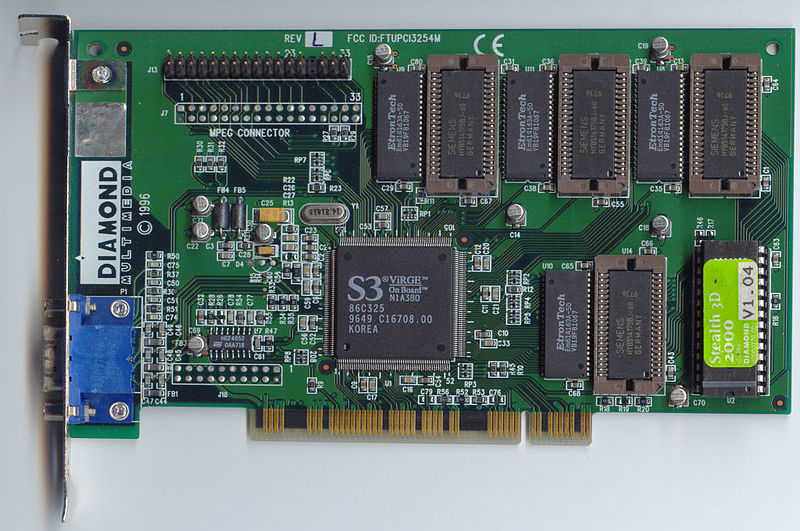
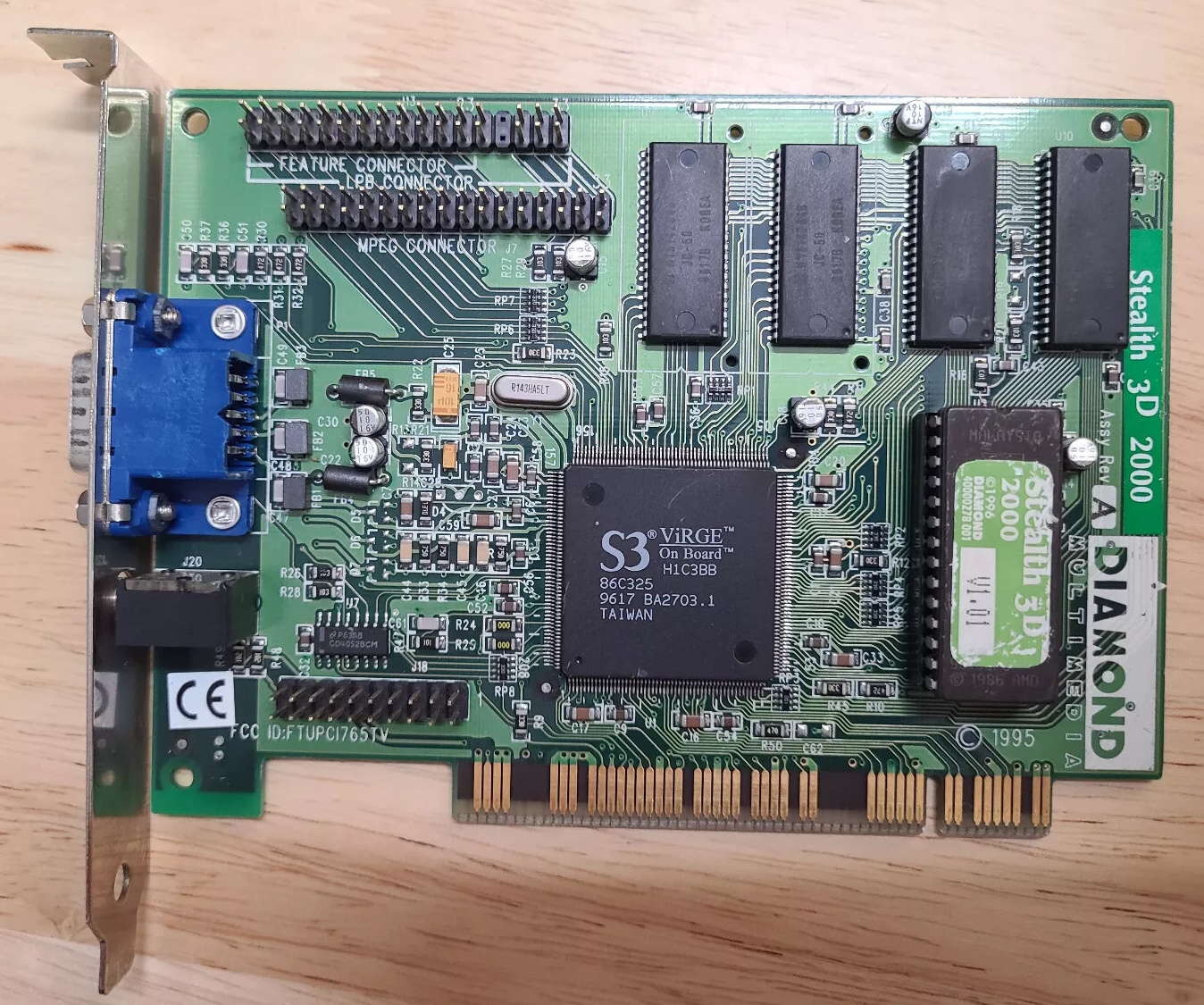
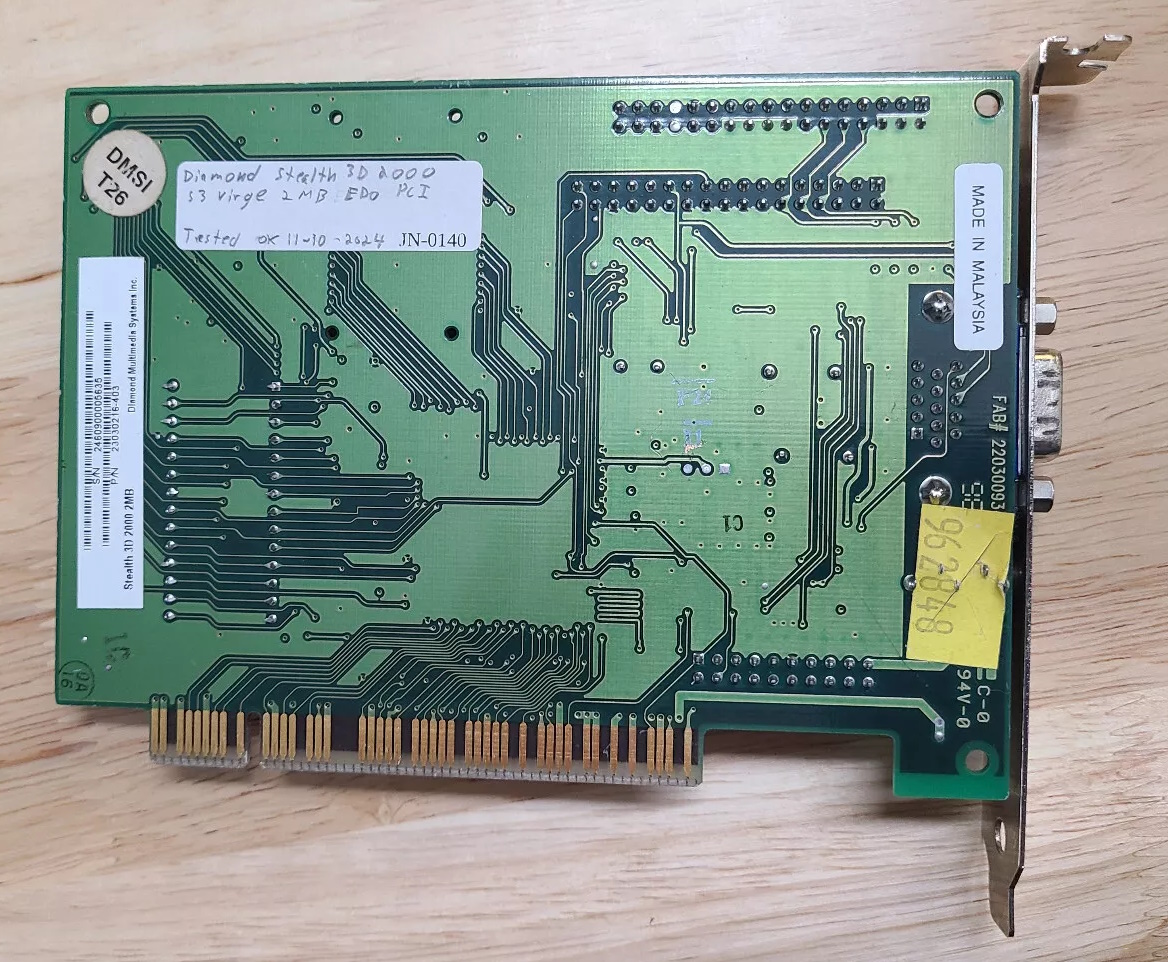
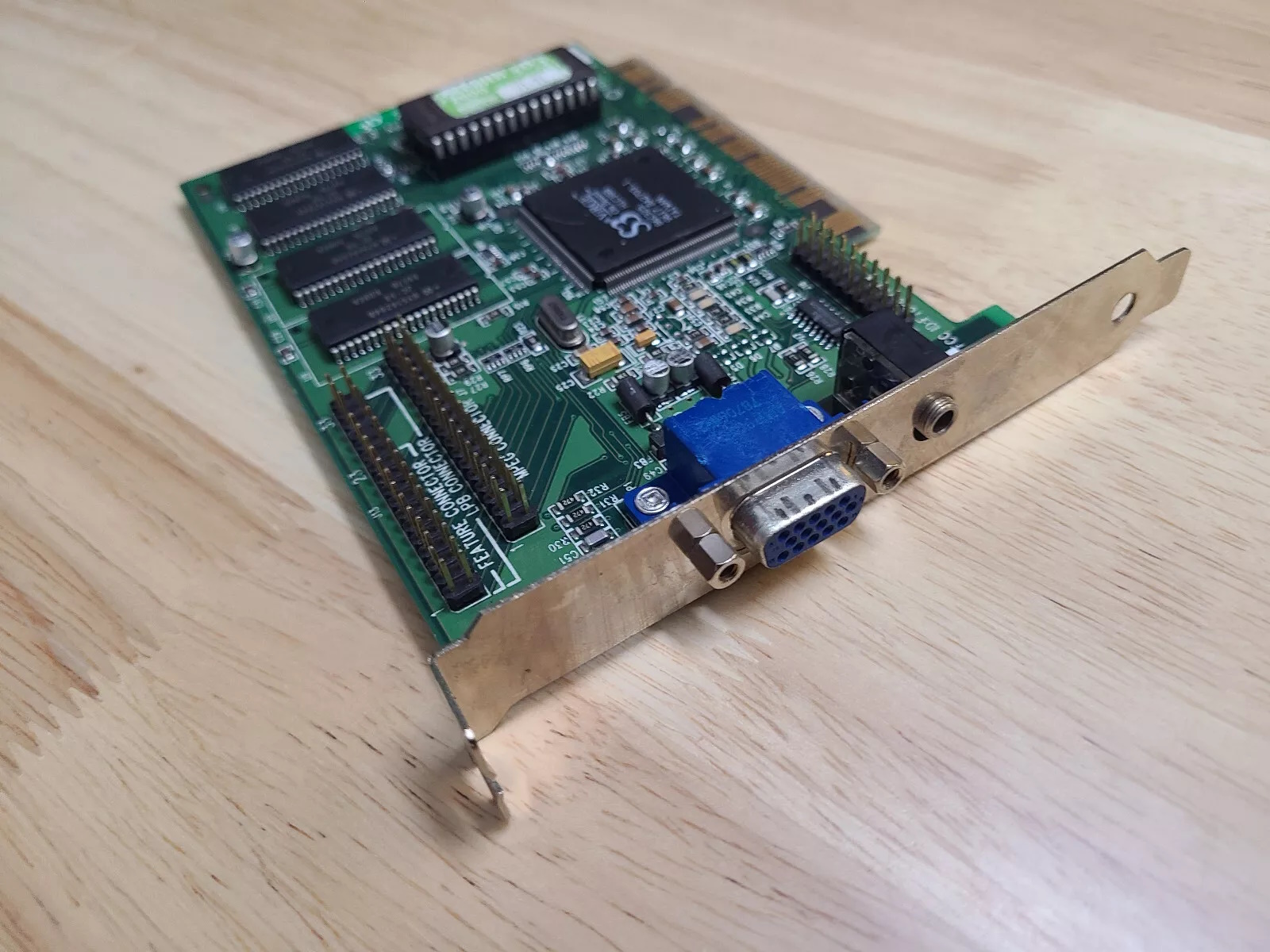
.jpg)
.jpg)
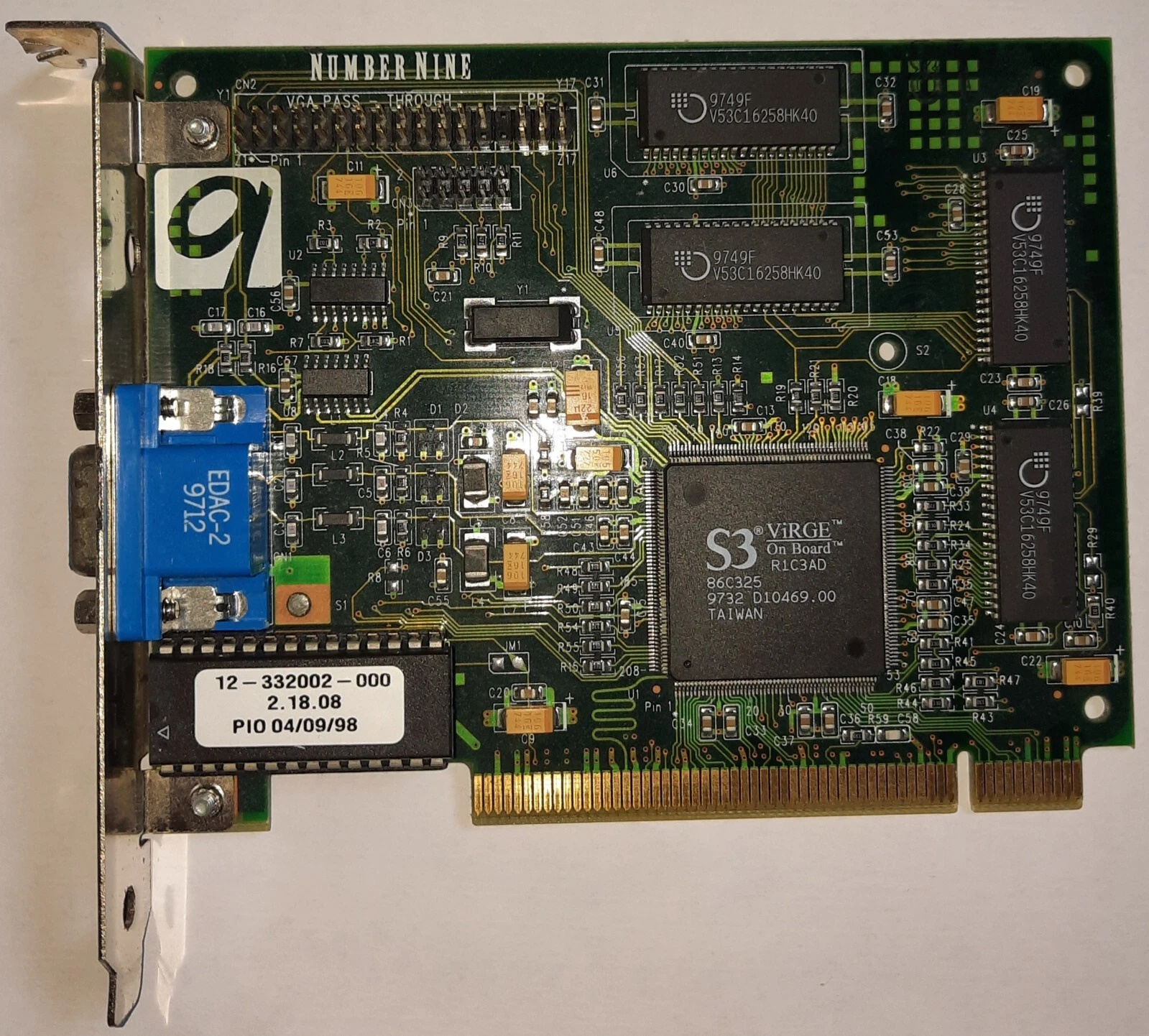
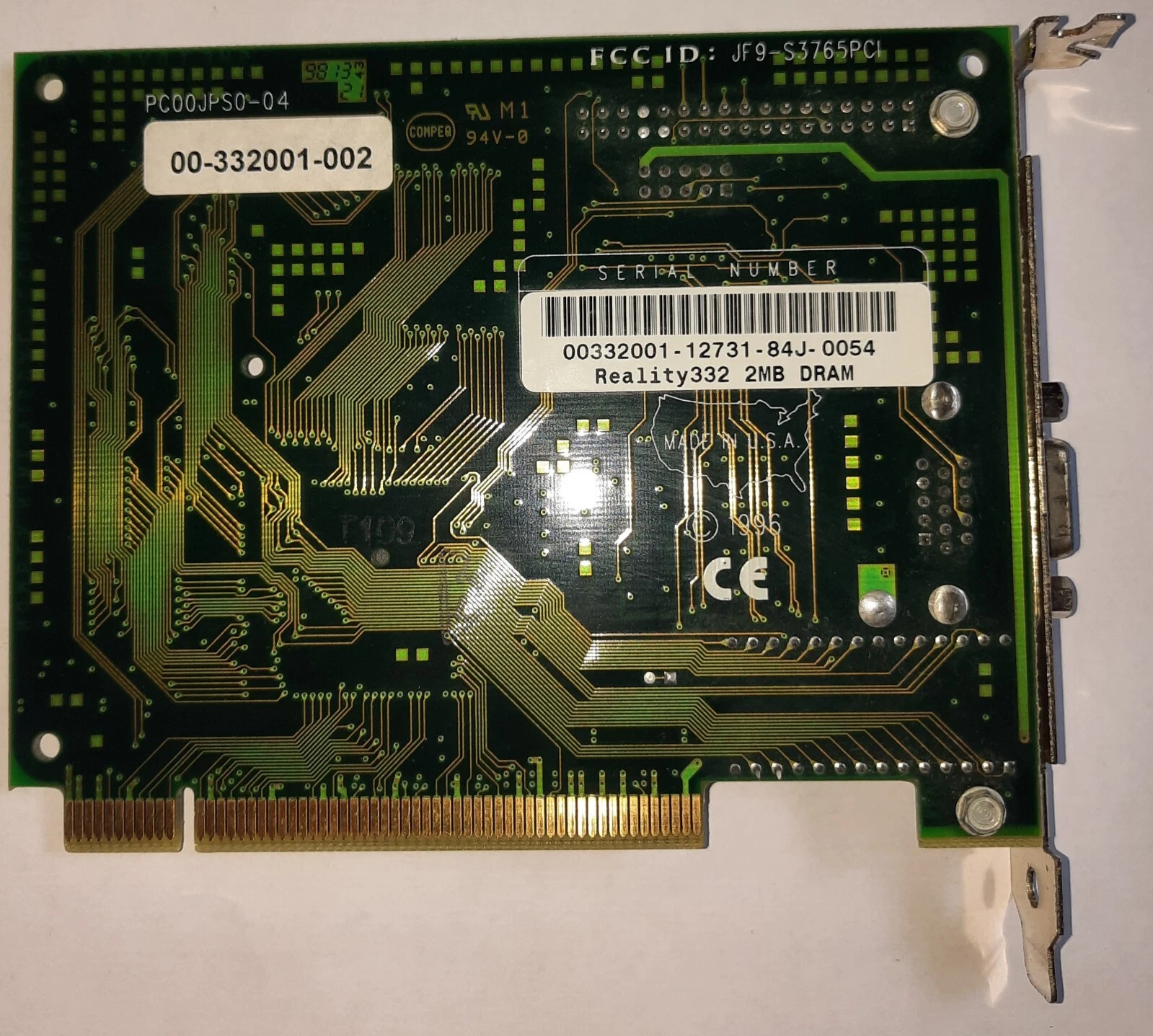
.jpg)
.jpg)
.jpg)
.jpg)
.jpg)
.jpg)
.jpg)